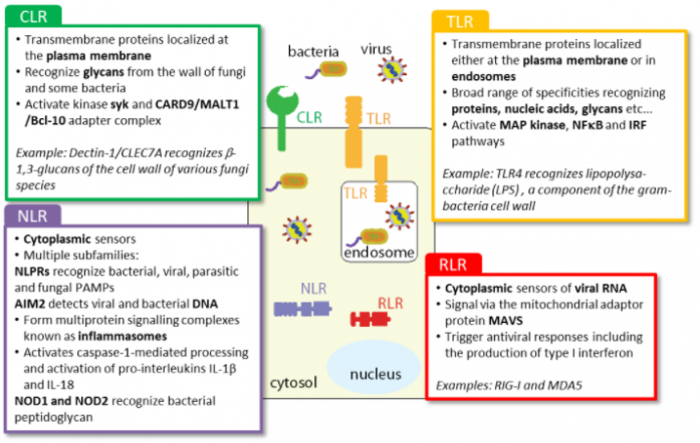The Human Immune System
The immune system detects and eliminates pathogens such as bacteria, viruses, fungi, and toxins. The human immune system consists of innate immunity and adaptive immunity. Innate immunity refers to the immunity that is naturally present, and adaptive immunity is activated by exposure to pathogens.
When innate immunity recognizes a pathogen that has entered the human body, it immediately responds regardless of the identity of the antigen. Macrophages, dendritic cells, NK cells, and neutrophils, which are innate immune cells, cause inflammation or remove foreign invaders through phagocytosis.
On the other hand, adaptive immunity remembers the identity of an invading pathogen, and can respond quickly and strongly when a second invasion occurs. B cells, which are adaptive immune cells, produce antibodies that neutralize viruses and bacteria. T cells activate cytotoxic T cells and helper T cells to eliminate invaders or induce further immune response.
Pathogen Recognition Process
For the immune response to function, the human immune system must recognize the foreign microbes that enter the body. Human immune cells use receptor proteins called PRRs (Pattern Recognition Receptors) to recognize PAMPs (Pathogen-Associated Molecular Patterns) or DAMPs (Damage-Associated Molecular Patterns).

Recognition of PAMPs by an APC Through PRR
PAMPs do not originally exist in human cells. They are specific proteins that exist in microorganisms such as bacteria, viruses, parasites, and fungi. APCs (Antigen-Presenting Cells) in the human body regard PAMPs as ‘non-self’ (foreign substances), and this triggers an innate immune response.
PAMPs
In immunology, the sources of PAMPs are known as bacteria, viruses, parasites, and fungi. Representative examples of PAMPs include bacterial and fungal polysaccharides, bacterial flagellin protein, viral RNA & DNA, and parasite GPI anchors.

PRR (Pattern Recognition Receptor) Families
PRRs are proteins capable of recognizing molecules frequently found in pathogens (PAMPs) and activate the immune system. There are four families of PRRs as follows;
• Toll-like receptors (TLR)
• Nucleotide-binding oligomerization domain-like receptors (NLR)
• C-type lectin receptors (CLR)
• RIG-1 like receptors (RLR)

Cancer Immunotherapy
Cancer immunotherapy is a drug that prevents cancer cells from evading the human immune system or makes immune cells better recognize and attack cancer cells. Many drugs such as TLR agonists and immune checkpoint inhibitors are being developed as immune anticancer drugs.
Cancer immunotherapy induces an immune response by appropriately stimulating immune cells, and the induced immune response remove cancer cells and abnormal cells in the body. Currently, researches on the development of immunotherapy are actively conducted.
Immunity and iNtRON
In existing immunology, the complex human immune system has not been fully elucidated. We recognize this limitation of immunology and seek to overcome this challenge with a new approach through bacteriophage. We also aim to discover new immune Regulators by studying the effects of bacteriophages on the human immune system.
There will be a substance that regulates the human immune system in the relationship between bacteria, viruses, and bacteriophages surely exists. Factors that interact with foreign bacteria, viruses and bacteriophages are also related to the human immune system, thereby causing or suppressing disease. We aim to achieve challenges and success in new and innovative fields that go beyond the relationship between bacteria and bacteria, and explore the relationship between bacteria, viruses, and bacteriophages, and the interaction with immunity.
it is iNtRON.
